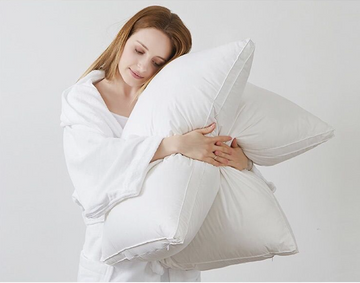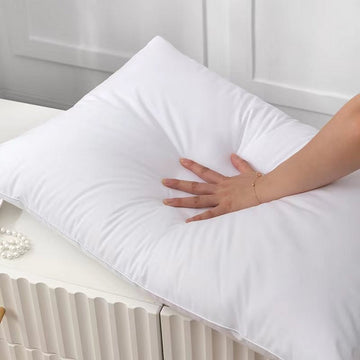Understanding the Role of Comfort Pillows in Sleep
The Importance of Comfort in Falling Asleep
Comfort isn't just a luxury; it's a necessity for slipping into deep, restorative sleep. The feeling of comfort as you lay your head down can signal your brain that it's time to unwind and let go of the day's stresses. Without comfort, our bodies remain tense, our minds stay active, and sleep becomes a relentless chase. A comfort pillow, designed to cradle and support, creates an immediate sense of relaxation, easing the transition from wakefulness to sleep. This support is key to falling asleep faster and staying asleep longer.
How Comfort Pillows Contribute to Quality Sleep
Comfort pillows can be vital for sound sleep. They align the neck and spine. This helps reduce pain and stiffness. A good pillow adjusts to your movements. It keeps your head at the right height all night. This can lead to deeper sleep. It may even cut down on snoring. For many, a comfort pillow is a key part of sleep quality.
The Impact of Material and Design on Pillow Comfort
- The material of a pillow affects breathability and temperature control.
- Memory foam contours to your shape but may retain heat.
- Natural fills like down allow airflow but may not provide firm support.
- Pillow design, such as contoured shapes, can support specific sleep needs.
- Removable covers allow for easy cleaning and material freshness.
- Hypoallergenic materials benefit those with allergies or sensitivities.
Selecting the Perfect Comfort Pillow for You
Assessing Your Sleep Style and Preferences
Choosing the perfect comfort pillow starts with knowing how you sleep. Think about your usual position - are you a back, side, or stomach sleeper? Each style has its own needs. For example, if you sleep on your side, you might need a thicker, firmer pillow to fill the gap between your head and mattress. On the other hand, stomach sleepers often need a softer, flatter pillow to keep their spine aligned. Back sleepers fall somewhere in between. Also, consider if you move a lot or stay still. This can affect the type of pillow that will best support your sleep. Start by assessing these preferences to narrow down your pillow choices.
The Different Types of Comfort Pillows Available
When searching for the perfect comfort pillow, you'll find several types. Memory foam pillows mold to your head and neck's shape. This offers tailored support. Feather pillows are soft and fluffy. They let your head sink in comfortably. Latex pillows resist dust mites and mold, keeping allergies at bay. Contoured pillows are for neck support, ideal for specific sleep issues. Buckwheat pillows are firm and adjustable, fitting to your unique shape. Microbead pillows provide a cooling effect, great for hot sleepers. Each type has unique benefits, so consider what suits you best.
The Key Features to Look for When Choosing a Comfort Pillow
- Support: Choose a pillow that aligns your head, neck, and spine.
- Fill Material: Memory foam, down, or latex affects comfort and support.
- Firmness: Pick a firmness level that feels right for you, based on your sleeping position.
- Hypoallergenic: If you have allergies, look for pillows that are hypoallergenic.
- Breathability: A pillow that stays cool can enhance sleep quality.
- Size: Ensure the pillow fits your bed size and your body.
- Durability: Look for quality that will withstand regular use.
- Ease of Cleaning: Consider if the pillow is machine washable for easy care.
- Warranty: A good warranty can provide peace of mind.
Implementing and Maintaining Your Comfort Pillow Strategy
Best Practices for Using Comfort Pillows
To make the best use of a comfort pillow, follow these tips:
- Choose the right loft based on your usual sleep position.
- Align the pillow with your neck and head for proper support.
- Adjust the pillow filling to suit your comfort levels.
- Use a protective cover to keep the pillow clean and hygienic.
- Flip and fluff your pillow regularly to maintain its shape.
- Avoid using multiple pillows that could misalign your spine.
- Consider the room temperature for optimal sleep comfort.
By following these simple practices, you can enhance your sleep quality and enjoy the full benefits of your comfort pillow.
Routine Care and Maintenance for Longevity
- Wash your pillow cover regularly, following care labels.
- Fluff your pillow daily to maintain its shape.
- Avoid direct sunlight to prevent color fading.
- Replace pillows every 1-2 years, or as comfort diminishes.
- Use a pillow protector to shield from dust and spills.
- Air out your pillow outside periodically to refresh.
- Follow specific care instructions for memory foam or down pillows.
- Avoid over-washing, which can break down pillow fibers faster.
Evaluating the Effectiveness of Your Comfort Pillow
To determine if your comfort pillow suits you, pay attention to your sleep quality. Do you wake up with neck pain or headaches? It may suggest your pillow isn't right. Notice if you're adjusting your pillow often. A good pillow should cradle your head with little movement. Your sleep position might change over time. Ensure your pillow still meets your needs. If it doesn't, consider looking for a new one. Remember, a pillow's effectiveness can wear off. Replace it when you see signs of wear or every 1-2 years.







